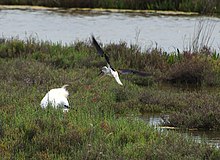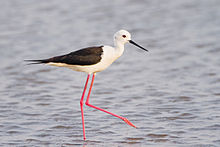Stilt
| Stilt | ||||||||
|---|---|---|---|---|---|---|---|---|

Stilt ( himantopus himantopus ) |
||||||||
| Systematics | ||||||||
|
||||||||
| Scientific name | ||||||||
| Himantopus himantopus | ||||||||
| ( Linnaeus , 1758) |
The stilt ( Himantopus himantopus ) is a species of the family of avocets (Recurvirostridae). In Central Europe, the stilt is an occasional and irregular summer visitor and occasionally breeding bird due to the large-scale change of location. The highest Central European breeding population is in the Hungarian lowlands with up to 400 breeding pairs. At the beginning of the 1990s, stilts also settled again on Lake Neusiedl , where the population had expired in 1860.
features

The most striking features of the stilt walker are its extremely long, red legs and the black, needle-thin, straight and long beak. The stilt reaches a body length of 33 to 36 centimeters, of which six centimeters are accounted for by the beak. The legs that extend 14 to 17 centimeters above the tip of the tail in flight are not included in the body length. The head, neck, underside and upper tail-coverts are white, the upper back and the underside and upper side of the wings are black. The back and shoulders of adult males have a greenish sheen, and of females a brownish sheen. In the females, this creates a clear contrast to the black wings. The partially black color of the head is more pronounced in males, but not a reliable feature for determining sex, as there are overlaps in the expression between the sexes. Most of the adult birds have a gray or distinctly black spot behind the eye, and the back of the head and neck can be black. This stain is not pronounced in youth clothing, the back of the head is breathed in gray. The legs of the young birds are flesh-colored, the back is clearly brownish and the wing feathers have light-colored tips, which creates a light-colored rear edge on the wings.
voice
The stilt is only vocal during the breeding season, otherwise little can be heard. Its most frequent call is a high-pitched, somewhat squeaky and quickly lined up sounding "kjück kjück kjück ...", which is similar to the call of the avocet , but has a less fluid and harder sound. In the event of an alarm, the stilt cries loudly and harshly “crit crit crit ...”, similar to the red lapwing . Another call sounds similar to that of the black-headed gull like a rolling "krre". The reputation of the young birds reminds "gipp!" At the Sandpiper .
Habitat and Distribution
The stilt lives in shallow water zones with fresh, brackish or salt water in lagoons , salt flats and steppe lakes . Its long legs allow it to search for food in deep water. It occurs mainly in southern Central Europe , on the Caspian and Black Seas and in Turkey . In some cases, however, it also broods in northern Central Europe. There are breeding populations in northern France and on the western Danube .
The stilt is a long-distance migrant and winters in Africa .
Reproduction
- Reproduction of the stilt
The reproductive behavior of the stilt has not yet been conclusively investigated. Monogamous seasonal marriage is probably the norm. The nesting site in the form of a shallow hollow is set up on the ground near shallow water or on small islands. The start of laying depends on the biotope and climatic conditions. In southern Europe, stilts start laying eggs in mid-April, otherwise this date is often between mid / late May and late June. The clutch usually comprises four eggs; the laying interval is one to two days. The eggs are clay to light olive brown and have very dense, small black-brown spots. The incubation period is 23 to 24 days. Both parent birds are involved in the brood. The young birds hatch synchronously and leave the nest either on the day of hatching or shortly afterwards. You are self-employed between 28 and 32 days.
Duration
The total European population is estimated at 37,000 to 64,000 breeding pairs at the beginning of the 21st century. The largest populations are in Spain, Turkey and Russia.
supporting documents
literature
- Hans-Günther Bauer, Einhard Bezzel and Wolfgang Fiedler (eds.): The compendium of birds in Central Europe: Everything about biology, endangerment and protection. Volume 1: Nonpasseriformes - non-sparrow birds. Aula-Verlag Wiebelsheim, Wiesbaden 2005, ISBN 3-89104-647-2 .
- Richart Chandler: Shorebirds of the Northern Hemisphere . Christopher Helm Publishing House, London 2009, ISBN 978-1-4081-0790-4
- L. Svensson, PJ Grant, K. Mullarney, D. Zetterström: The new cosmos bird guide - All species of Europe, North Africa and the Middle East. Franckh-Kosmos Verlags-GmbH & Co., Stuttgart 1999, ISBN 3-440-07720-9
Web links
- Himantopus himantopus in the endangered Red List species the IUCN 2008. Posted by: BirdLife International, 2008. Accessed January 31 of 2009.
- Videos, photos and sound recordings about Himantopus himantopus in the Internet Bird Collection
- Age and gender characteristics (PDF; 2.7 MB) by J. Blasco-Zumeta and G.-M. Heinze (eng.)
- Feathers of the stilt





